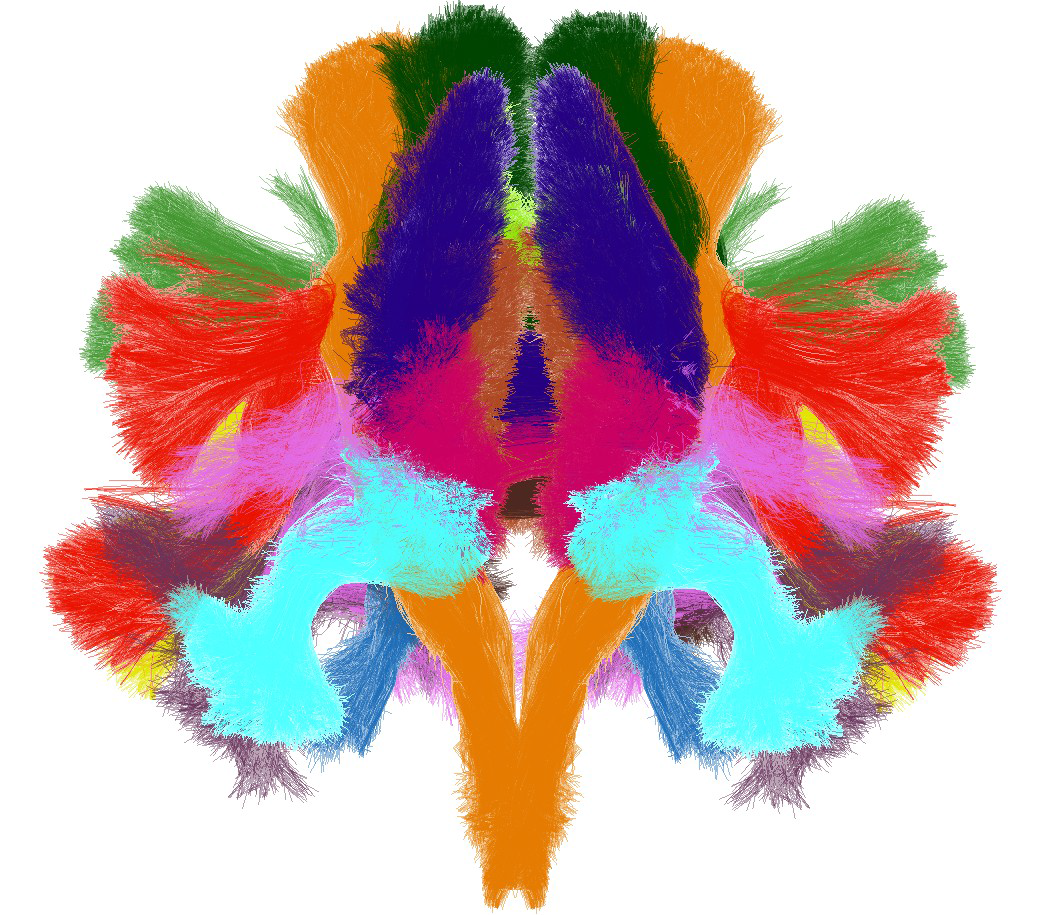Because NeuroSpin is headed but the inventor of Diffusion MR imaging (dMRI), METRIC team is expert in this field and works actively on its development. For two decades, diffusion weighted imaging has become popular because it is the only technique which allows to access in vivo to human brain anatomical connectivity. Water diffusion imaging in the brain lies on the statistic observation of the water molecule free motion in the tissue restrained by the cell membranes. The motion is more restrained in the white matter. WM is essentially composed axonal fibers surrounded by myelin protective coat which improves nerve impulse transfer efficiency. These fibers are set parallel and arrange in bundles which define the information « highways » between functional areas located at the cortex surface and the deep structure so called brainstem nuclei. The very anisotropic organization of the WM can be deduced from MRI, staring the diffusion process which has a more limited restriction into the principal fiber direction. The fiber trajectory can be then reconstruct using so called tractography technique which stands on the knowledge of the distribution of the diffusion process orientation in every single brain region.
The team has built an important knowledge both on innovative acquisition sequence development and on the data analysis. It is also a partner of the CONNECT European consortium gathering the 10 cutting-edge teams working on human connectum.
In this context, it develop the “Connectomist” software platform integrating all the needed steps to study the connectome structure and it has also published the first human brain anatomic atlas displayed on the next Figure.
Beyond the angular profile of water molecule displacement, dMRI allows to probe the biological tissues at the cell scale, because throughout its microscopic movements, the water molecules bump into cell walls (glial, neuronal, axonal, astrocytic…) and therefore encode membrane geometry of these cells. All the work of the biophysicist is to « decode » this information and modelling the different brain tissues with this help of simple mathematical templates of the membrane geometry. At the end of the first decade of the 21st century, this new modality is on his way to transform MRI into a fantastic virtual biopsy tool allowing a none-invasive exploration of the tissue organization at the cell scale: it is called microscopy by diffusion MRI or μdMRI. NeuroSpin has made the methodological MRI developments which enable it to offer to its platform customers the microscopy diffusion MRI sequences (Lebois et al, 2012) in addition to the associated analysis tools that we have shown the forcefulness building the first quantitative atlas of the large bundles of the white matter, as illustrated on Figure 4 (Assaf et al, 2013 ; Duclap et al, 2013 , Schmitt et al, 2012).
The NeuroSpin 7T clinical scanner includes a very powerful gradient system delivering 80mT/m in addition to the strongest static magnetic field available in France. It also has got a sequence offering the possibility to adjust the diffusion gradient pulse shape and duration. Thus we can set the trapezoidal gradients as it has been described by Stejskal et Tanner (Pulsed Gradient Spin Echo ou PGSE) in their classical scheme, to set AxCaliber et ActiveAx protocols, to set eventually sinusoidal gradients (Oscillating Gradient Spin Echo ou OGSE) as it has been proposed by Does (Does et al, 2003), or to set arbitrary shapes (Arbitrary Spin Echo ou ASE) as described by Callaghan and more recently by Drobjnak (Drobjnak et al, 2011). Altogether, this features allows us to set a more ambitious diffusion microscopy protocols than at 3T.
Two protocols have been validated at 7T one based on simple Pulsed Gradient Spin Echo using trapezoidal gradients which has demonstrated to map exquisite corpus callosum cytoarchitecture of 10 healthy volunteers as illustrated on Figure 5 (the corpus callosum has been chosen as a test bundle, because the direction of the fibers is known and can then bring modelling simplification). In any corpus callosum location, a local axonal density, average diameter can be provided in addition to average angular dispersion. Expected profiles can be found along the sagittal medial plane, with a higher axonal density and a lower axonal diameter at the knee and the splenium of the corpus callosum, and with a lower axonal density and higher axonal diameter at the corpus level. We retrieve also a lower angular dispersion at the level of the central part of the corpus callosum than at in the splenium and the knee regions. This work demonstrates the considerable potential of microscopic diffusion MRI to develop new biomarkers of the cerebral pathology, bringing more relevant information on the physio pathological mechanisms involved than scalar parameters like Apparent Diffusion Coefficient (ADC), Fractional Anisotropy (FA), both extracted from angular profile model of the diffusion weighted signal, and therefore do not allowing usually to understand and characterize fine modifications of the tissue operated at the cellular scale during the course of the pathology.
METRIC belongs to the European Human Brain Project (https://www.humanbrainproject.eu) which has the final objective to simulate the human brain. In the context, we work in close collaboration with UNATI and UNIACT and numerous European laboratories (Pr Katrin Amunt and Karl Zilles teams at the Forschungszentrum Jülich mainly ) in the Work package 2 with the goal to build the first quantitative atlas of the white matter ultra-structure and of the cytoarchitecture of the cerebral cortex using microscopy diffusion MRI.
 |  |